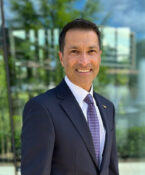UNT Health Science Center facility earns LEED Gold
The University of North Texas Health Science Center‘s newest facility, the Medical Education and Training Building which opened in May, has received a LEED Gold designation for meeting strict environmental standards.
The Medical Education and Training Building on the Health Science Center’s Fort Worth campus is the first UNT System facility to be designated LEED Gold. Two other recently completed buildings – Academic Building 2 at UNT Dallas and the Life Sciences Complex on the main campus in Denton — have applied for the designation.
Leadership in Energy & Environmental Design (LEED) is an internationally recognized green building certification system, providing third-party verification that a building was designed and built using strategies to improve energy savings, water efficiency, carbon dioxide emissions reduction, improved indoor environmental quality and stewardship of resources. The LEED program was developed by the U.S. Green Building Council beginning in 1993.
The Gold Designation reiterates the UNT System’s commitment to sustainability, which has set a minimum standard for all new construction to be LEED Silver or higher.
"We have an obligation to build campuses that minimize use of resources and don’t harm the environment," said Richard Escalante, Vice Chancellor for Administrative Services. "There is also the very practical matter of cost. We keep our buildings 50 to 75 years, and by building in this manner, the sustainable features for energy efficiency of the buildings pay for themselves typically within eight years. Plus, environmentally responsible buildings mean healthier buildings with better air quality."
The UNT System commitment to building green grew from an initiative by Chancellor Lee Jackson to construct future buildings to meet or exceed LEED standards.
When compared to a similar building of the same size that is not built to LEED standards, the building will:
- save approximately 250,000 gallons of potable water each year, exceeding industry standards by more than 50 percent.
- save approximately $55,000 annually in electricity and natural gas costs, exceeding industry standards by more than 25 percent.
Sustainable Features of the Medical Education and Training Building:
- The building construction generated more than 30 tons of waste, of which over 28 tons (92.4 percent) was diverted from the landfill through recycling.
- More than 20 percent of the construction material contained recycled content and/or was extracted, processed and manufactured within 500 miles of the project site.
- Building materials and ventilating systems were designed to improve indoor air quality.
- The building fire suppression system does not contain ozone-depleting substances such as Halon or CFCs.






Social media